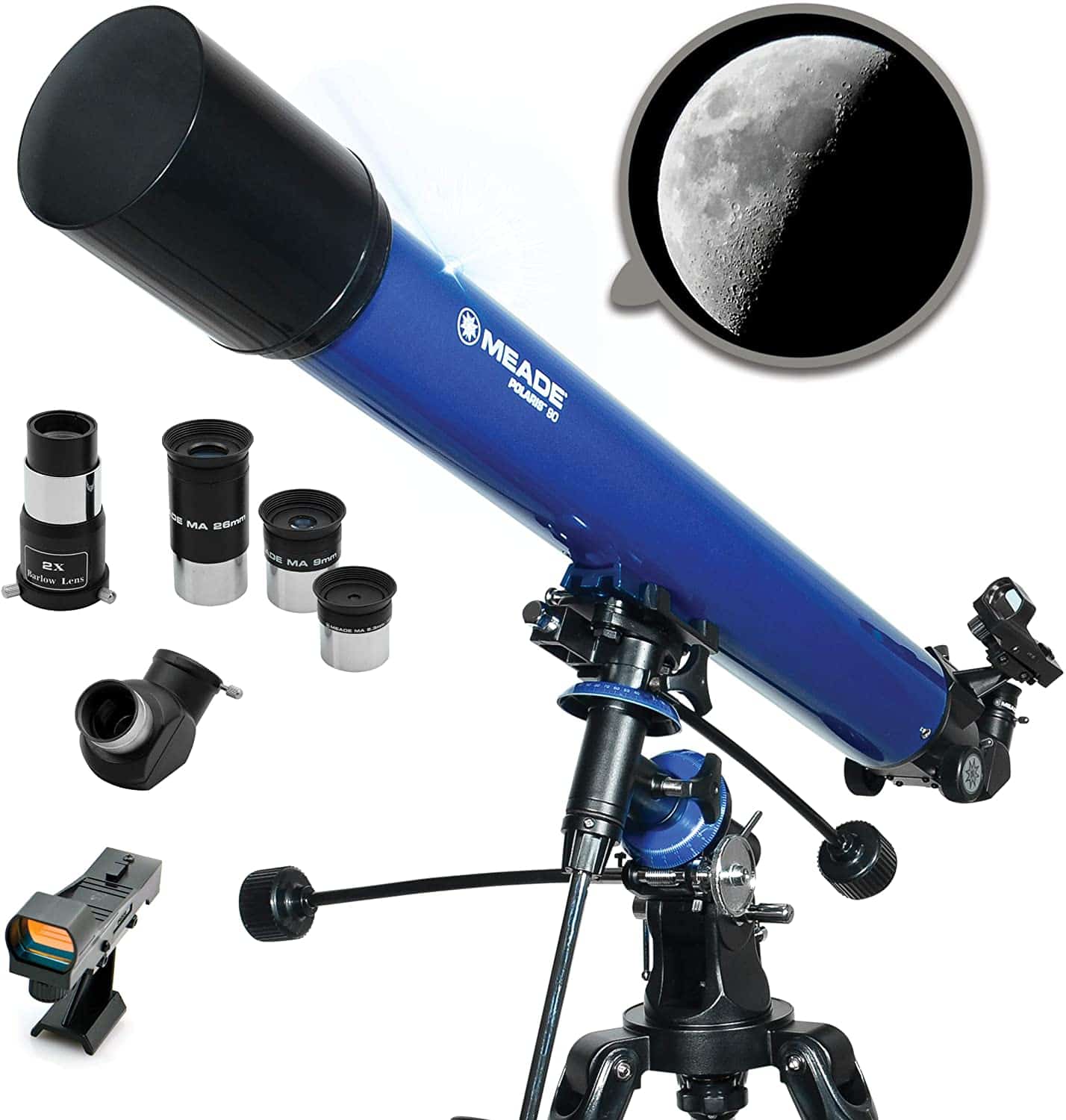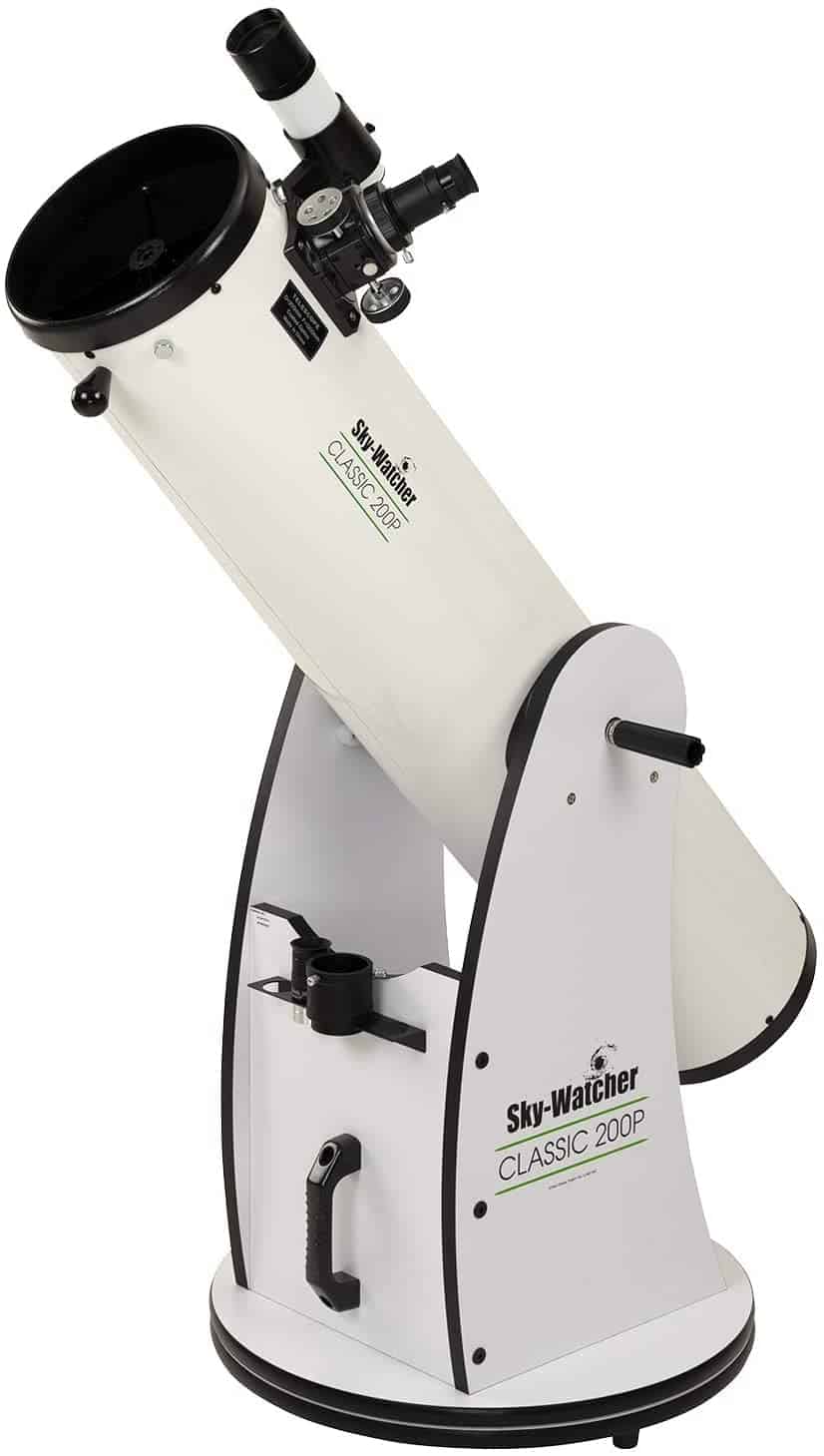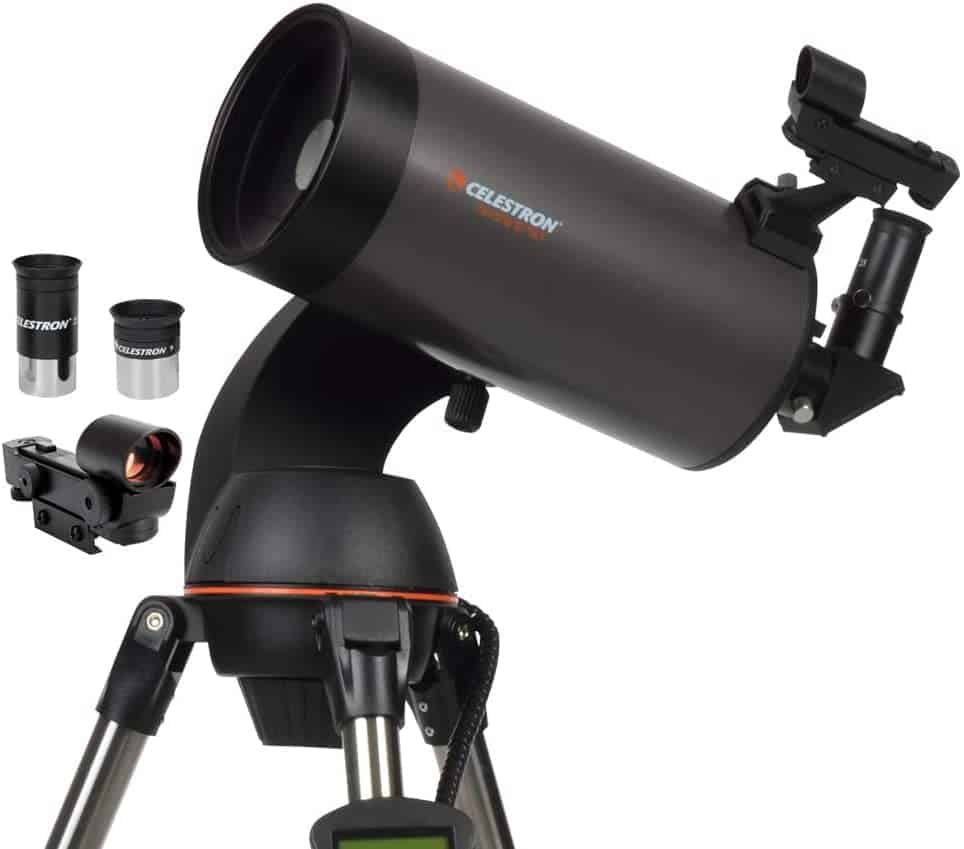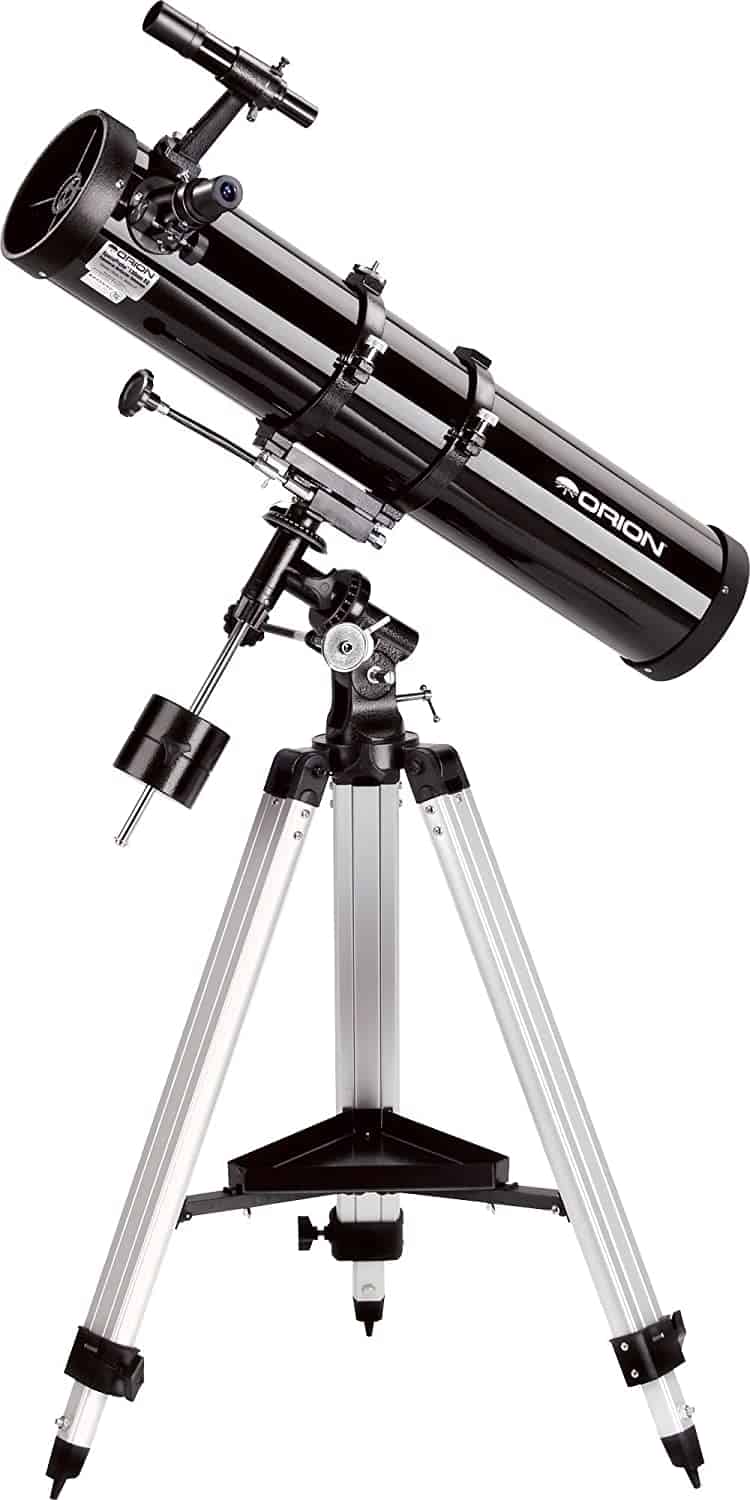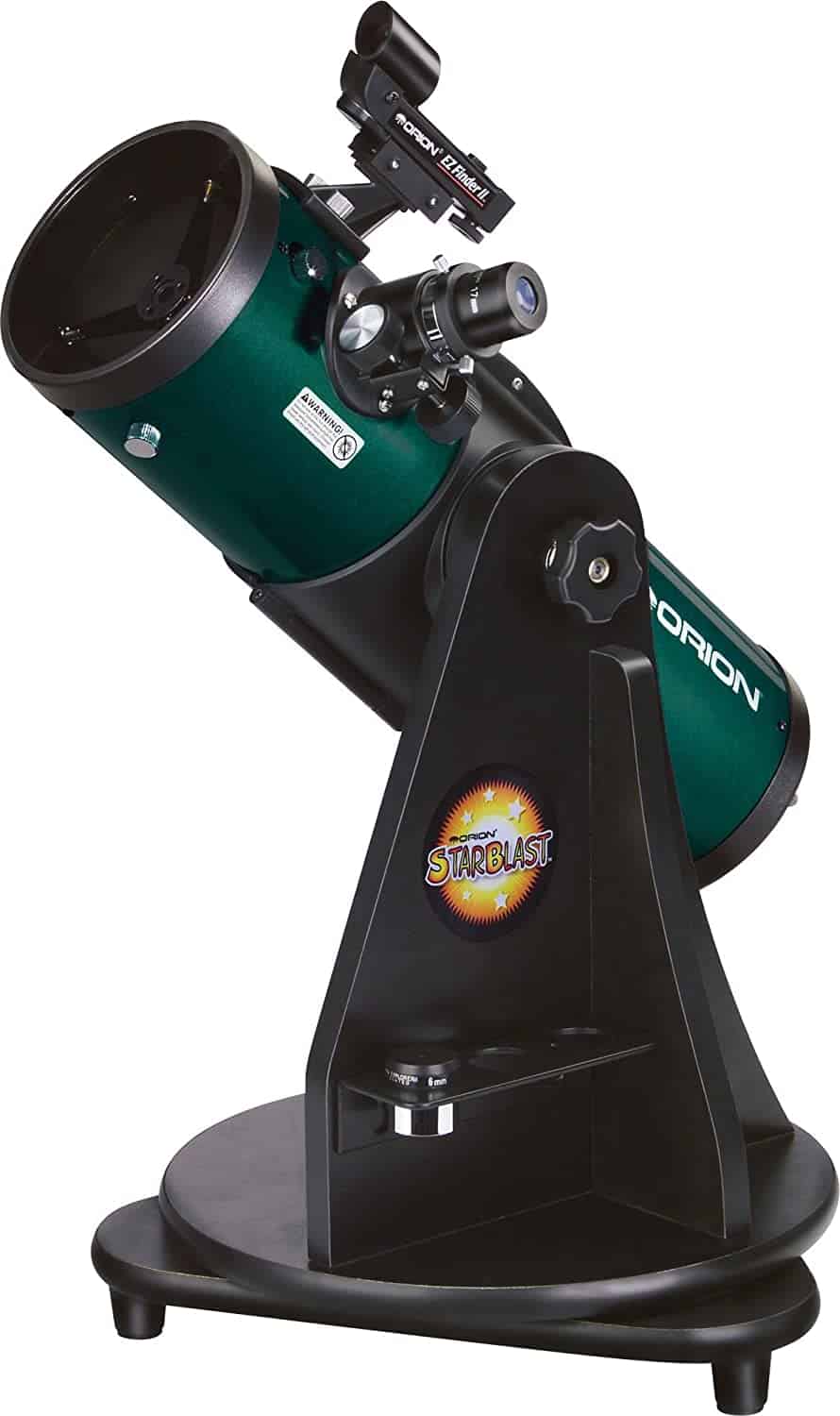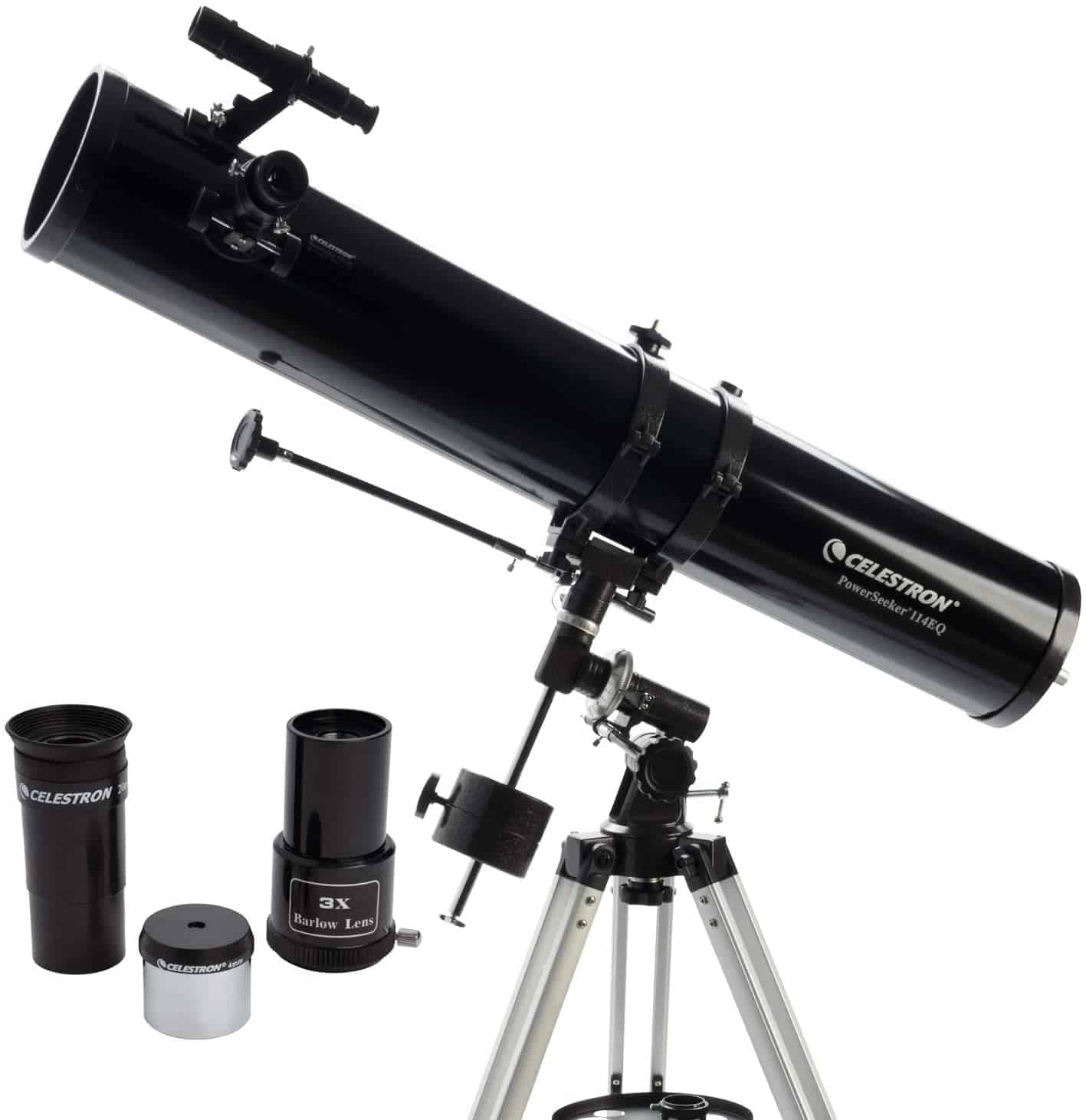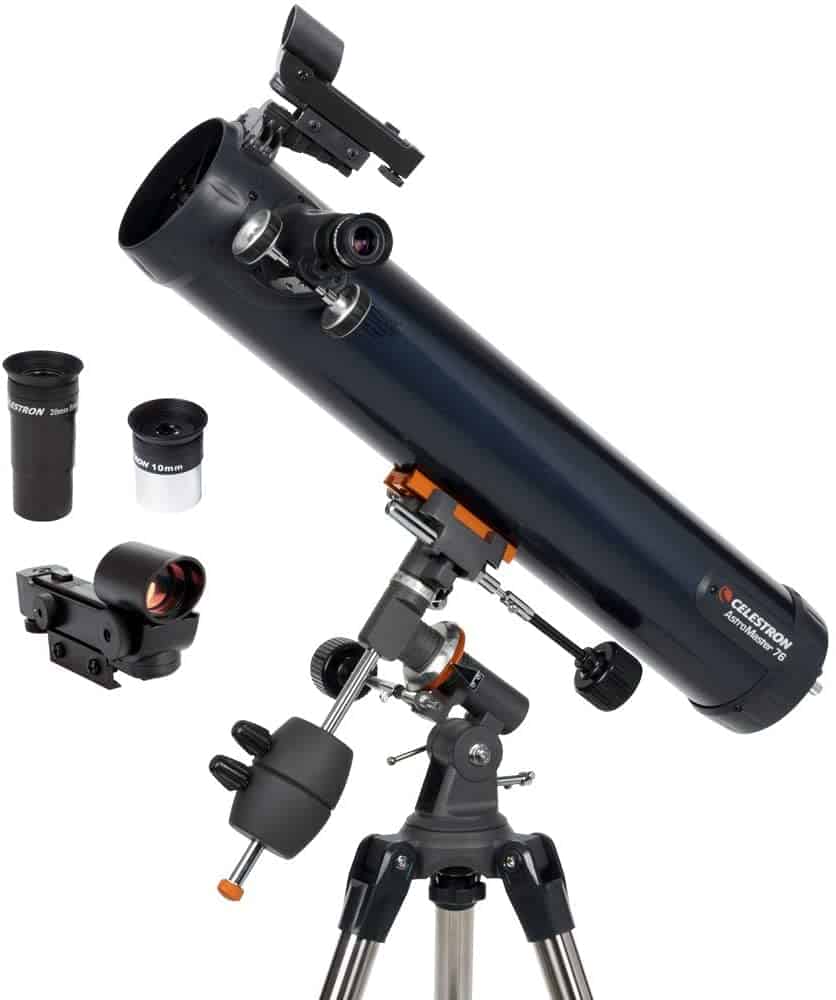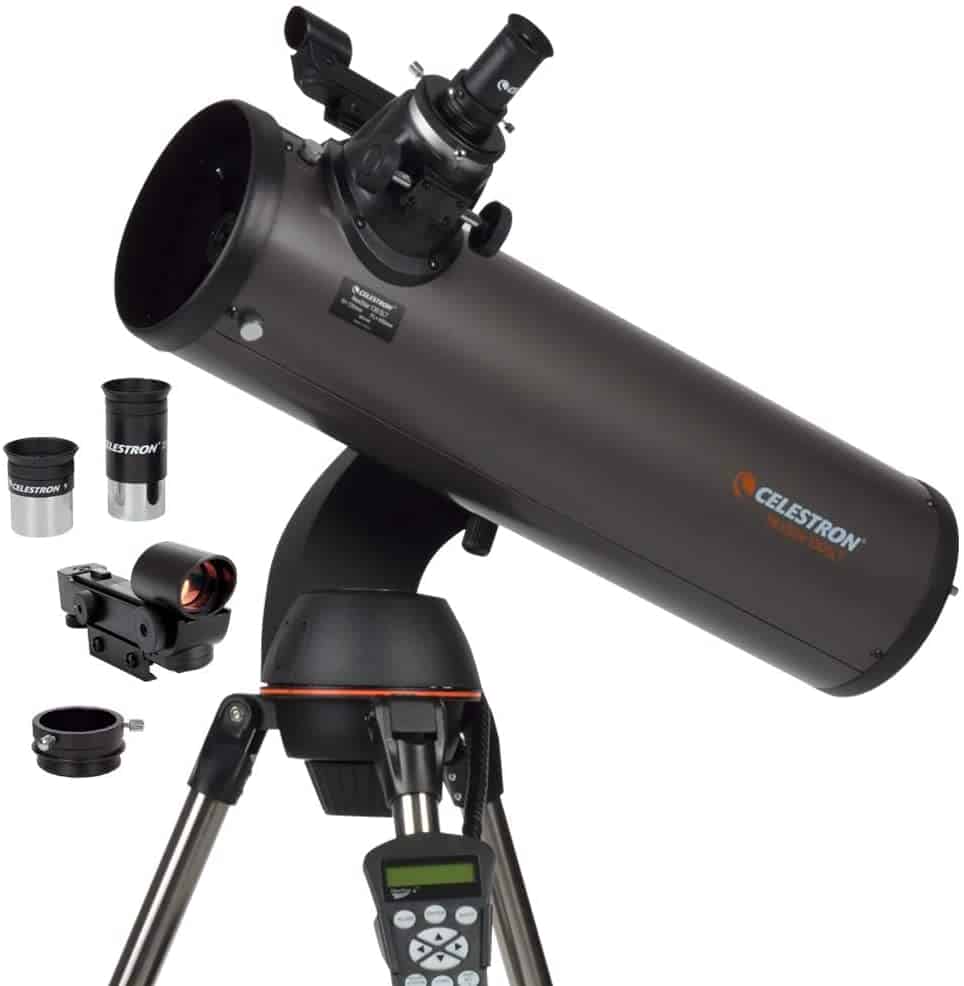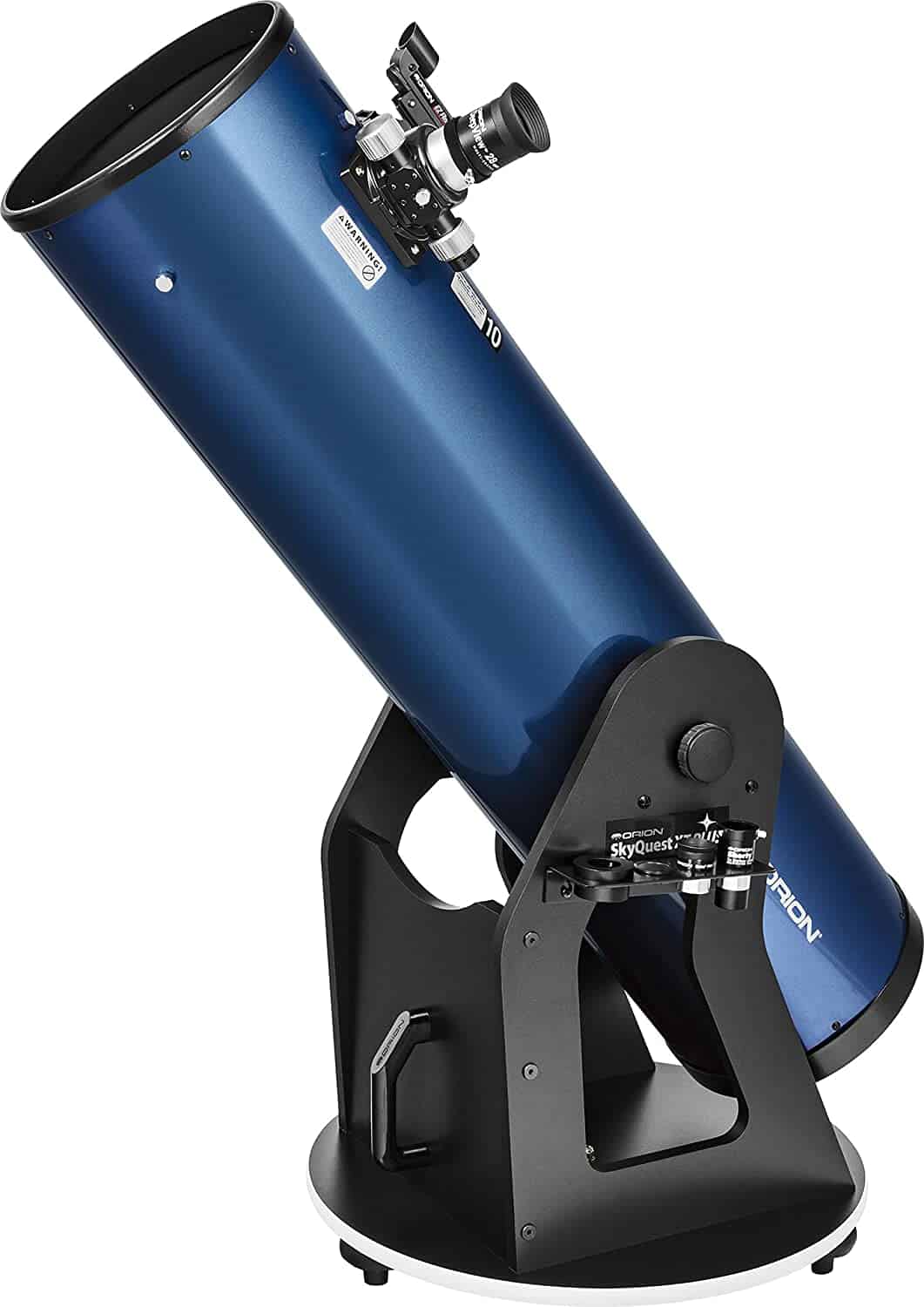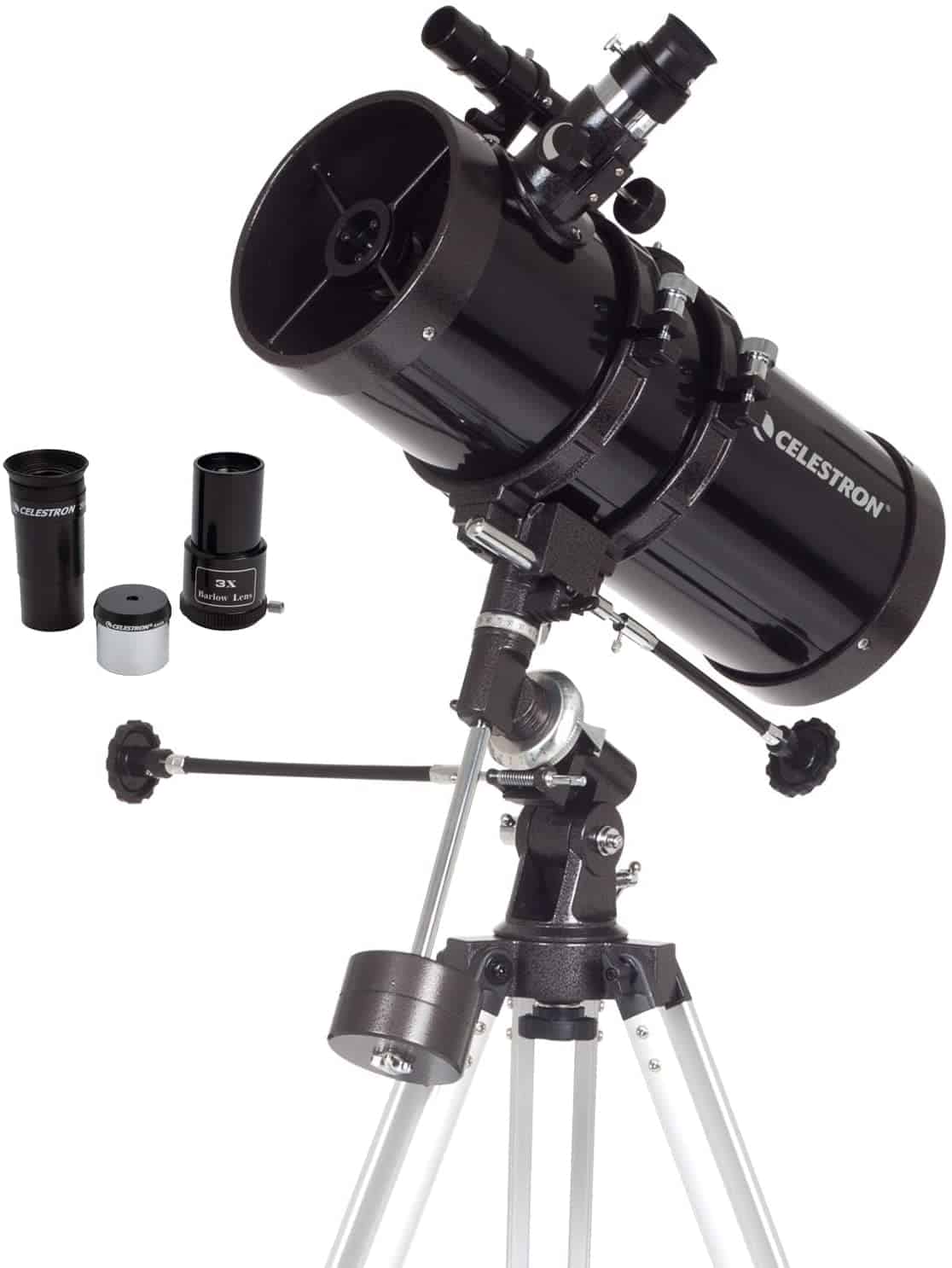Since the beginning of time, man has been a curious creature. When exploring the earth and discovering the newest species that lived among us on this planet got boring, we decided to start looking beyond our world, and into the skies.
With the help of the best telescopes for deep space objects, galaxies, and nebulae, you can satisfy that craving for infinite knowledge that every man has inside of their souls.
To learn everything about telescopes and the best models present in the market to view deep space objects, read on!
Our Overall #1 Rated Pick
This telescope is a refracting telescope and has a 90mm aperture. This telescope has a focal ratio of f/10. Moreover, it has a focal length of 90 mm. The product has a unique design that has motion control, which makes it easy to track and view celestial objects.
This telescope has a stable German Equatorial mount, which has a large size. It has a low magnification of 26mm, medium magnification of 9mm, and high magnification of 6.3mm. This product has a 2x Barlow lens, which adds to its efficiency by doubling the magnifying power.
The 10 Best Telescopes Comparison Chart
Image | Product Name | Ranking | Price |
|---|---|---|---|
1 4.40 | |||
2 4.20 | |||
3 4.20 | |||
4 4.20 | |||
5 4.50 | |||
6 4.10 | |||
7 4.40 | |||
8 4.20 | |||
9 4.90 | |||
10 4.00 |
The 10 Best Telescopes Out There
With so many great products in the market, it is really difficult to differentiate a quality product from the one that is just advertised in a better way. Let’s take a look at our honest reviews of best telescopes for deep space objects, galaxies, and nebulae, to help you understand your product better, along with their pros and cons!
This telescope is a refracting telescope and has a 90mm aperture. This telescope has a focal ratio of f/10. Moreover, it has a focal length of 90 mm. The product has a unique design that has motion control, which makes it easy to track and view celestial objects.
This telescope has a stable German Equatorial mount, which has a large size. It has a low magnification of 26mm, medium magnification of 9mm, and high magnification of 6.3mm. This product has a 2x Barlow lens, which adds to its efficiency by doubling the magnifying power.
This telescope has a red dot on the lens. This red dot viewfinder makes it easy to point at the object. To capture the object properly, it has 1.25” erect image diagonal prism.
Not only this, but it also has Rack and Pinion Focuser and Setting Circles. Its accessory tray makes it stable. This telescope comes with an astronomical software DVD. The package also contains a tripod stand.
PROS
CONS
Skywatcher S11610 has a large aperture, which helps to get a bright and clear view of space objects. This product has a unique and efficient design. The handles attached to this telescope prevent vibrations and allow for smooth movement of the telescope.
This telescope helps you to view celestial objects without any disturbance. Its primary and secondary mirrors are fully coated, which makes them reflective. These mirrors are 94% reflective mirrors. Its smooth working and movement are assured by Proprietary Teflon Bearings.
The bearings help in the smooth azimuth movement. It has a 2 inch Crayford style focuser and one ¼ inch adapter. It has two eyepieces with a wide-angle. This telescope is lightweight, which makes it portable.
The telescope is very easy to assemble, and you do not need to spend hours to figure out how to use this telescope.
PROS
CONS
This Celestron telescope is a computerized telescope that is more advanced than any of your ordinary telescopes. It has a database of more than 40000 space objects. This telescope helps you to locate the desired object with accuracy.
It has a compact design and is suitable for both starters and experts. This telescope is very portable, i.e., you can take it anywhere with you. Its compact design also makes it easy to assemble this telescope. It has a large aperture of 127mm, which gathers enough light to view deep space objects.
You can easily see distant space objects in clear detail, such as Saturn’s rings, Jupiter’s cloud bands, and the moon. This telescope does not need much effort to make it ready to use. It has two eyepieces of 9mm and 25mm.
The product is very user friendly. The company also provides free astronomy software with the package. The package also contains a tripod stand. They assure its durability and efficiency and offer a warranty of two years.
PROS
CONS
Orion 9851 SpaceProbe 130 EQ is a reflector telescope. It has an aperture of 5.1 inches. This telescope comes with a large tripod stand whose size can be adjusted according to the requirement. It has an equatorial mount that helps you to track the objects easily in the night sky.
This telescope has a focal length of 900 mm. Its focal ratio is f/6.9. This ratio helps to view objects in the dark and wide sky. The telescope makes it easy to view cloudy nebulas, star clusters, and galaxies. It has an aperture of 130 mm that allows the entrance of a large amount of light from the sky and helps you to view space objects.
The telescope mount feature prevents extra motion and allows you to observe the object without any disturbance and interference. This reflecting telescope consists of two eyepieces of 25 mm and 10 mm focal length.
The aiming of the telescope becomes a lot easier because of the 6 x 30 finder scope. The product also comes with the astronomy software. The package also contains an instruction DVD.
PROS
CONS
Orion 10015 StarBlast 4.5 Astro Reflector Telescope has a compact design. The assembly of this telescope is so easy that even a beginner can deal with it easily. This telescope is suitable for both beginners and experts.
The compact design makes it portable, and you can take it anywhere with you. It has a focal length of 450mm. It has an aperture of 4.5 inches. This telescope has a focal ratio of f/4, which makes it easy to identify and view the target object.
The telescope has borosilicate glass material with low thermal expansion. The tabletop mount provides a steady and stable movement to track the space object easily. This amazing Orion telescope has two eyepieces of focal length 17mm and 6mm.
Along with the telescope, the package has an eyepiece rack, astronomy software, and collimation cap too.
PROS
CONS
This Celestron PowerSeeker 114EQ Telescope is manual. It is easy to use and is an efficient telescope. It has a unique and user-friendly design, which will help you to view the space objects. The telescope has a German Equatorial mount, which helps keep it steady during use.
You can easily fix the position by tightening the knob. It has a compact design. This telescope is favorable for both the kids and elders. It is portable, i.e., you can take it anywhere with you. It has an aperture of 144mm, which allows the entrance of a large amount of light.
It comes with two eyepieces of 200 mm and 4 mm in length. Moreover, the telescope also has a Barlow lens to triple the power of each lens and a finder scope too. The package also comes with the top-rated astronomy software. The company assures the efficiency and durability of the telescope and offers a warranty of two years.
PROS
CONS
Celestron AstroMaster 76EQ Newtonian Telescope is a reflector telescope. It is user friendly and is very easy to use. This telescope consists of fully coated optics, which make it an excellent reflecting telescope. It has a very supportive and lightweight frame.
Moreover, it comes with the StarPointer red dot finder scope. The package contains a tripod stand, which can be adjusted according to the requirement. The telescope has a fully coated 76mm primary mirror at the center.
The telescope mount makes the movement of the telescope steady and hence easy for you to target the object. All this makes it easy to view both celestial and terrestrial objects. Overall the telescope is very lightweight and is portable.
You can also take it with you while traveling. The telescope has two eyepieces having focal lengths 20 mm and 10 mm, respectively. The package also comes with top-rated astronomy software. The company offers a warranty of 2 years which confirms its efficiency and long life.
PROS
CONS
Celestron NexStar 130SLT Telescope is a computerized telescope. The telescope has efficient working and has the accuracy which no other telescope offers. This telescope is compatible with both kids and adults. The telescope has a compact design, which makes it portable. You can take it with you on trips.
It has 130 mm aperture, which gathers a lot of light and makes it possible for you to view the objects. Its fully coated mirrors make it a reflective telescope. It comes with the top-rated software and a tripod stand too.
The company also offers a two years warranty for this telescope. It comes with an accessory tray also to manage the working.
PROS
CONS
Orion SkyQuest XT10 Dobsonian Telescope is a reflector telescope. It has a fully coated mirror. This product comes with additional accessories that support its use and makes it user friendly.
This telescope comes with a two inches dual-speed Crayford focuser with a ratio of 11:1. It provides clear, bright, and sharp views. It has a 10 inches wide aperture, which allows a large amount of light to enter.it has a base mount with a knob to adjust the altitude.
The telescope consists of adjustable secondary mirrors. This telescope helps you to view the faint galaxies, nebulas, and other pace objects. You can now have ultimate fun with your interest in sky objects because Orion SkyQuest XT10 plus Dobsonian Reflector Telescope is there for you.
The package includes a 28mm eyepiece, which is a deep view eyepiece, and 1.25 inches 10mm Sirius Plossl eyepiece. The package also contains a Barlow lens, eyepiece rack, and much more.
PROS
CONS
Celestron – PowerSeeker 127EQ Telescope is a manual telescope. It is a powerful telescope with very easy use. It comes with good features and stable working. This scope is a reflecting telescope. It has a German Equatorial Mount, which helps in stable working without making the telescope too shaky.
Adjust and point the telescope in the desired direction and then fix the position by tightening the knob. This telescope is user friendly and works for both the starters and experts. It has a wide aperture of 10 inches.
It comes with two eyepieces, Barlow lens, eyepiece rack, and much more. Its fully coated mirrors make it 94% reflecting telescope. Through this, all the entering light is transmitted to the eyepiece. The image appears as a bright and clear one.
The frame and material are very lightweight. Its compact design makes it portable, and you can carry it with you anywhere. So now, enjoy capturing space objects with this amazing and user-friendly telescope!
PROS
CONS
Buying Guide
Looking for the device that can help us have a peek at the mysteries of the galaxies beyond the limit of our skies? Telescopes let us say hello to the comets and nebulae. Not everyone these days can understand the working of telescopes, but in reality, it is not that difficult of a concept to understand.
Let’s see what features should be present in a good quality best telescopes for deep space objects, galaxies, and nebulae and how they work!
About Deep Space Telescopes
Primarily there are a series of lenses placed in a cylindrical tube that has a certain aperture and laws of optics just do the work to paint a picture of the space in your eye through a small peeping hole.
The magical thing is that those objects stay the way they are, as they appear smaller from a distance; telescopes just magnify that image with the help of few curved surfaces and lenses perfectly placed and aligned to unravel the mysteries of the world.
As it is obvious, there is a lot of science involved with the viewing of those objects with such a distance, the creation of various types of telescopes was bound to happen.
Below there is some information about the different types of telescopes that exist in the market for the common man to have their way at it, and some additional information about the images they create.
Types of Telescopes
Refractor Telescopes
These are the earliest forms of telescopes that were made to view distant objects, and they are also called a dioptric telescope. Their primary function depends upon the lens that is placed at one end of the cylindrical tube and is used as the object to form the image of any distance material.
The cylindrical straight tube is connected to an eyepiece through which one can view the image being produced at the lens. Such telescopes were popular back in the early nineteen hundred, but since then, technology has one-upped its game and invented much better telescopes.
Reflecting Telescopes
Yet another feather in the cap of Sir Isaac Newton, reflecting telescope, is also one of his inventions. As opposed to the typical refracting telescopes, the reflecting telescopes use one or a series of curved mirrors that reflect light bouncing off of distant objects to form an image at the eyepiece.
Such type of telescope is a significant improvement over refractor telescopes as they cause many disturbing chromatic aberrations. There are many divisions and advancements made on the principle that reflector telescopes use to function appropriately.
Since the primary picture forming object is a mirror, this type of telescope is often written as catoptric telescopes. The primary curved mirror is placed at the brink of the cylindrical surface, which produces an image at the focal plane with the help of light reflected from distant objects
The image formed at the focal plane can also be directly viewed through the eyepiece. Most major telescopes such as the Hubble telescope and many conventional telescopes use this technique in their telescopes to create great results.
Aperture
The diameter of the surface that collects the refracted light from the distant objects is the aperture of a telescope. For refractor telescopes, the aperture is determined by the diameter of the objective lens, and for reflecting telescopes, the diameter of the primary mirror is in question.
As it is pretty simple, the wider the aperture will be, the more amount of light it will be able to absorb, and hence it will be able to produce a finer and clearer image of distal objects. A typical telescope must have at least 70 mm or 2.8 inches aperture to create a quality image.
Image Quality
The reason there have been so many, and such sudden advancements in the practicability of telescopes are that the field of astronomy is very challenging and the boundaries of this universe are ever-expanding, so we always need to take a better picture of the view out beyond the skies to understand the dynamics of the universe.
There is always a limit to how far we can look. After this, optical aberrations start to settle in producing a distorted and unclear image. It is vital to check the limit of the telescope to which it can produce a clear image without any distortion to be safe from any future disappointment.
Ease of Use
Most of the time, the people who purchase these telescopes are the ones who are buying them for their children who have shown interest in this field of astronomy. It is crucial that these telescopes must be easy to set up and use.
If there are some technical components, they must be explained thoroughly in the guide that should come with the telescope package. Any failure in using the telescope rightly can result in discouragement of a new-comer to the field, rendering the telescopes useless and the kid dropping out of the field.
Base Support
One of the most crucial factors in capturing the perfect image of a distant object is to have a steady telescope. This is only possible when the telescope has firm base support, and there are different types of base supports depending upon the surface you are planning to place the telescope on.
The table supports are different than the floor supports; it is imperative to check every possible way you can set-up your telescope before purchasing one. Secondly, on the matter of support, tripod stands are also often necessary while creating the perfect angle for viewing the mystical objects of outer space.
If the company is offering a tripod stand with the telescope as an accessory, then make sure that the tripod stand must be adjustable, as you might need to change the length of the stand as per your comfort.
Portability
Many times, there are special locations where specific special objects from space can be sighted. For such explorative purposes, landscapes or mountain tops are the hot zones. Most often, astronomers like to take their personal equipment on their voyage to view the astronomical wonders of the universe.
For such purposes, it is essential that the telescope set must be portable and easily break down into compact pieces that can then be transported to distant places without being a burden.
Accessories
The telescope itself is not an independent technical machine as it needs a bunch of accessories to reach its full potential. The base support, as mentioned above, is one of the most sought-after accessories that have the ability to make or break the image created by the telescope.
The second vital accessory is a tripod stand that should be adjustable so you can change the length according to a posture you are comfortable in, as we all understand these astronomical wonders often take their time in showing their face.
The last but not the least vital accessory is a digital monitor or a connection that can help project a captured image on the screen and probably let you document and share it so that you can save any important images that you might view on your quest.
User Manual
For a newbie that has recently developed an interest in the strangely intriguing astronomical world, these telescopes can be tricky to handle as we all know that these telescopes are pretty delicate objects and need to be dealt with utmost care.
Setting up a telescope and connecting all the dots for creating the structure from parts can be extremely nerve-wracking for someone who is new to the game. It is crucial that the set must include a manual that could dictate one step by step on how to build their telescope.
These instructions will not only help the future astronomer, but they could actually help explain the complexities of the outside world and take its picture to create a better understanding of everyone around.
Cost
The technology used in the making of these telescopes is pretty advanced and up-to-date with repairing any optical errors that might appear due to technical issues.
The cost depends upon the level of complexity and the type of telescope you purchase. It is crucial that you must assess your needs before putting up an order for a telescope as it is something you only purchase once or twice in your life.
FAQs
Which type of telescope is better, Refractor or Reflector?
Essentially reflector telescopes are better because they are built with newer concepts, and technology has taken this type to move further along with the studies of the universe. But on a good night, the refractor telescope can work just as good as a reflector.
What factors influence the distortion in image quality?
Most often, the external factors such as environmental conditions and droplets on the objective lens can cause a distorted image. The technical factors can be a damaged mirror or objective lens, or a shorter aperture. There are many things that go wrong while capturing a picture of outer space, so it is hard to pinpoint just a few aspects.
What is F? What is its significance in a telescope?
F stands for ‘focal length’ in the optical field. The focal length is the distance between the optical centers of the lens to the image plane. The greater the focal length, the more magnified is the produced image.
Final Words
Telescopes are an amazing invention of science that allows us to take a peek at the majestic universe. There is so much out there in the universe that is ready to be discovered, and all of that information is not only intriguing but also essential in understanding the creation of all the galaxies.
So, get your gear straight and start your voyage into the mysteries of the universe by choosing one of the best telescopes for deep space objects, galaxies, and nebulae from our list.

